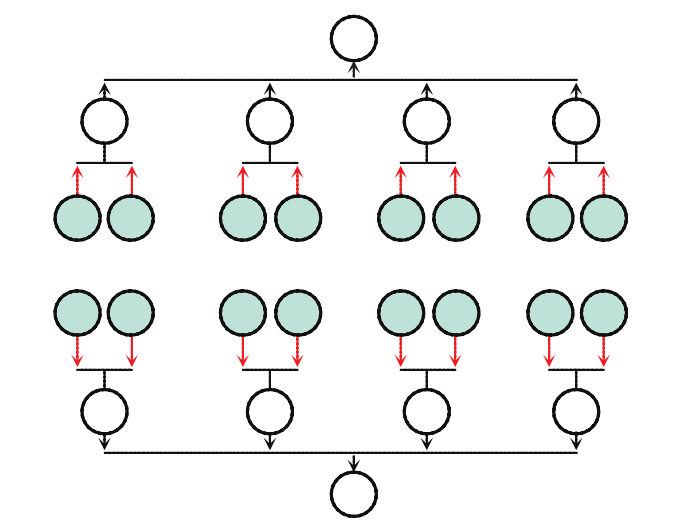Bottom-up approach to hierarchy
Start at many, keep consolidating to one
Two copies of the standard simple hierarchy diagram. The top one has a single node at the top; the bottom one has a single node at the bottom. The entry points are blue, and in the most populated line; the link to the next level has a red arrow pointing from the entry to the consolidation. In the top diagram, the arrows point up to the row of 4 nodes. In the bottom diagram, the arrows point down to the row of 4 nodes.
With a bottom-up approach, someone(s) is taking all the data and forming categories from the data.
I’ve seen people look at the final representation and insist that the defining node is still the single one alone on its line. This is despite any visual signals or verbal/written course correction. They see the stack and know what they know, their brains turning it to read the ‘right’ way. It’s a form of cognitive bias.
What tends to happen when bottom-up hierarchy is the initiating architecture
- Finds an effective label to pull together contextual relevance, rather than building context into wishful labels.
- Nothing can eliminate all cognitive biases, but this sets up to be more likely to reveal them until data is ‘set aside’ and lost/left out.
- Edge cases are more likely to be included, adding to truthiness; however, they are rarely kept updated
- Takes more time to de-complexify
- If the time is taken to continually re-evaluate data and re-form the categorization, it moves with uncovered understanding while providing a known framework to help introduce it to fresh eyes
- It’s more likely to become a moving target, which will spark emotions in people who are glancingly interested or predicating a deadlined, efficient workflow on it
- Despite it’s democratized initiation, it still tends to work like a top-down hierarchy in the long run; as more people leverage the structure, bad actor behaviors gravitate towards the ‘positions of authority’, and slowly change the movement of the data until they can ignore the misalignments with the vast quantity of the population
This is mostly based on first- to third-person watching. It’s been influenced by library studies, UX, and democratic standards.
bottom-up:
cognitive bias, context, emotions, garbage-in, taxonomy
cognitive bias, context, emotions, garbage-in, taxonomy
